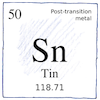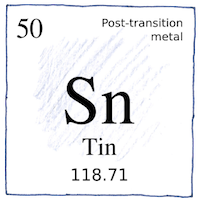Mesopotamia, Balkans
elements

|
Tin
Tin was discovered as an impurity in copper ore that made copper stronger and easier to cast into something useful and beautiful. Arsenic, also an impurity in copper ore, seemed just as good but turned out to be toxic, so pretty soon people were mining tin to make bronze.
Atomic number 50
Cassiterite, stannite, cylindrite, franckeite, canfieldite, and teallite, are the ores found in granite and purple placer deposits. Halide compounds such as stannous chloride, organotin hydrides such as tributyltin hydride, organotin compounds such as diethyltin diiodide are the useful and toxic chemicals. Tributyltin oxide used as a wood preservative and antifouling paint for ships are banned for toxicity to marine life, but by itself tin is totally non-toxic. Tin solder, tinsmith, cookie tins, tin plating, tin cans, tin badges, pewter is mostly tin, bronze a fifth tin, organ pipes of tin or tin alloy, terne, lead and zinc alloyed with tin, for steel plating, stannous fluoride used for dental fillings, are the cultural artifacts. If you put a tin farthing in my tin cup, I’ll shine up my tin talisman and invoke the tintinnabulation of the bells—
Tin mistakes
They said that Napoleon’s army froze in Russia because their buttons were reduced to powder from tin pest, but no survivors told of problems with buttons. They said that Buddhist singing bowls are made of the five Buddhas or the seven metals, but really they contain only copper and tin. They said that the goat on the garbage heap ate tin cans but he was really chewing the labels glued with something tasty. and they said tin soldiers had no hearts but they died the same as any other soldiers with just as much pain and blood.



A tin mine, especially in Cornwall or Devon, is called a stannary. The Latin word for tin was stannum, possibly borrowed from the Celtic. The chemical symbol for tin is Sn.
See also in The book of science:
Readings in wikipedia:
Other readings: